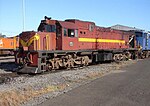
The majority of Indonesia's railways are on Java, used for both passenger and freight transport. There are three noncontinuous railway networks in Sumatra while two new networks are being developed in Kalimantan and Sulawesi. Indonesia has finalized its plan for a national railway network recently. According to the plan, 3,200 km of train tracks that will criss-cross the islands of Sumatra, Java, Kalimantan, and Sulawesi, it has been touted as the most extensive railway project in Indonesia since its independence from the Dutch in 1945. Indonesia targets to extend the national railway network to 10,524 kilometres by 2030. As of September 2022, the network spans 7,032 km.

PT Kereta Api Indonesia (Persero) (lit. 'Indonesian Railways (State-owned) Limited', abbreviated as PT KAI or simply KAI) is a major railway operator in Indonesia and one of the public railway companies in the country. It is state-owned and pays track access charges. Its headquarters are located in Bandung, West Java. In 2019, KAI carried 429 million passengers and 47.2 million tonnes of cargo.
PT Industri Kereta Api (Persero), abbreviated as INKA, is an Indonesian state owned rolling stock manufacturer.

Argo Bromo Anggrek is the name of executive and luxury train jointly operated by Kereta Api Indonesia between Surabaya and Jakarta in Indonesia. The train covers 720 kilometres (447 mi) in 8 hours and 5 minutes along Java's north coast, stopping at Bojonegoro, Semarang Tawang, Pekalongan, and Cirebon. It is one of the best known trains in Indonesia.

The EMD GT38AC diesel-electric locomotives are made by Electro-Motive Diesel for export in Indonesia. There are 91 locomotives owned by the state-owned Indonesian Railway Company, all of them are for in Sumatra and replace the aging EMD G26. It's also one of two most advanced-technology locomotive in Indonesia.

The GE CM20EMP diesel-electric locomotives are owned by Kereta Api Indonesia and built by GE Transportation. The GE CM20EMPs are multipurpose locomotives, not only for hauling passenger trains, but also freight trains.

Argo Jati is a train service operated by Indonesian Railway Company between Jakarta and Cirebon in Java, Indonesia. This train was relaunched on November 3, 2010, as a replacement train series of Argo Jati, which was launched in 2007.
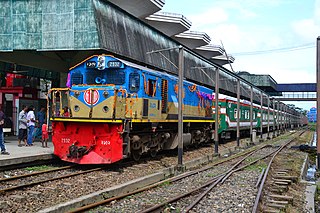
Parabat Express is an intercity train which runs between Dhaka and Sylhet, two important cities in Bangladesh. It has been considered one of the most prestigious and luxurious trains since the inception of intercity train in Bangladesh in 1986.

Argo Parahyangan, also commonly known as GOPAR is an executive and economy premium class train operated by Indonesian Railway Company between Gambir railway station, Jakarta and Bandung in Java, Indonesia. The train covers 166 kilometres (103 mi) in 2 hours 50 minutes. From Jakarta to Bandung the train stops at Bekasi and Cimahi where as from Bandung to Jakarta it stops only at Jatinegara. KAI operates 34 trips daily in the route.

Argo Wilis is an executive and panoramic class train operated by PT Kereta Api Indonesia between Surabaya and Bandung in Java, Indonesia. The train covers 696 kilometres (432 mi) in 9 hours and 53 minutes with stoppage at Cipeundeuy, Tasikmalaya, Ciamis [id], Banjar, Kroya, Kutoarjo, Yogyakarta, Solo Balapan, Madiun, Kertosono, Jombang, and Mojokerto. This train runs in the morning from Bandung to Surabaya Gubeng or vice versa, and arrives at the destination at evening/night. In the journey Bandung to Surabaya, passengers can enjoy the beautiful panorama of the eastern part of Parahyangan mountainous region.

The PNR 8000 class is a diesel multiple unit (DMU) train operated by the Philippine National Railways (PNR) since 2019.
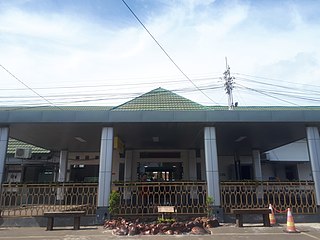
Kroya Station (KYA) is a railway station located in Bajing, Kroya, Cilacap Regency, Central Java, Indonesia. The station has nine railway tracks. It is a major junction station where the line from Yogyakarta split, where one goes to Purwokerto and Cirebon, while other head to Bandung.

The EA203 series is an Electric Multiple Unit produced by Industri Kereta Api, in collaboration with Bombardier which will be used as Soekarno–Hatta Airport Rail Link express services from Manggarai Station in Jakarta to Soekarno–Hatta International Airport at Tangerang, Banten. EA203 series was purchased by PT Railink, a joint venture between PT Kereta Api Indonesia and PT Angkasa Pura II which is the operator of the airport train in Indonesia, totaling 60 units divided into 10 series with 6 car formations. EA203 series was sent from its factory in Madiun to Jakarta in stages starting in August 2017.

Jombang Station (JG) is a large class type C railway station located in Jombatan, Jombang, Jombang Regency, the station is included in the Operation Area VII Madiun at an altitude of +43 m. The location of this station is right across the Alun-alun Jombang. All trains passing the Kertosono-Surabaya Gubeng must stop at this station.
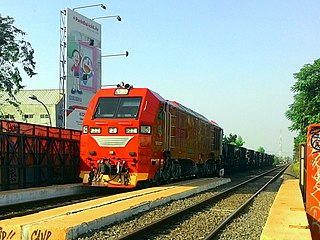
The INKA CC300, also known in the Philippines as the PNR 9000 Class, is a multipurpose Diesel-hydraulic locomotive owned by Directorate General of Railways and built by Indonesian state-owned rolling stock manufacturer PT INKA. Launched in 2013, it is the first mainline locomotive wholly produced by Indonesia and the first locomotive exported by Indonesia to another country, when the Philippine National Railways (PNR) received its first set of INKA CC300 locomotives in December 2020.

Sri Lelawangsa is a commuter rail service in Indonesia operated by KAI Bandara, serving Medan Station to Kuala Bingai Station route and vice versa. The service began operation on 6 March 2010 using Kereta Rel Diesel Indonesia (KRDI) DMU by INKA. But now the Sri Lelawangsa train series has changed to a Local Economy Class train pulled by locomotive BB302, BB303 or BB203.

Purwakarta Station (PWK) is a class I railway station located in Nagritengah, Purwakarta, Purwakarta Regency. The station, which is located at an altitude of +84 meters, is included in the Operational Area II Bandung. This station is located very close to the Purwakarta regent's office which can be reached on foot.

The PNR 8300 class, also referred to as INKA coaches, is a class of locomotive-hauled passenger coaches operated by the Philippine National Railways since 2021.
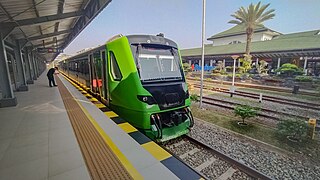
The KCJB feeder train is a train service operated by Kereta Api Indonesia on the Padalarang–Bandung route in Greater Bandung, West Java, Indonesia. This train operates as a feeder for the Jakarta–Bandung Whoosh high-speed railway passengers from Bandung and Cimahi city areas to the high-speed railway hub at Padalarang Station.









